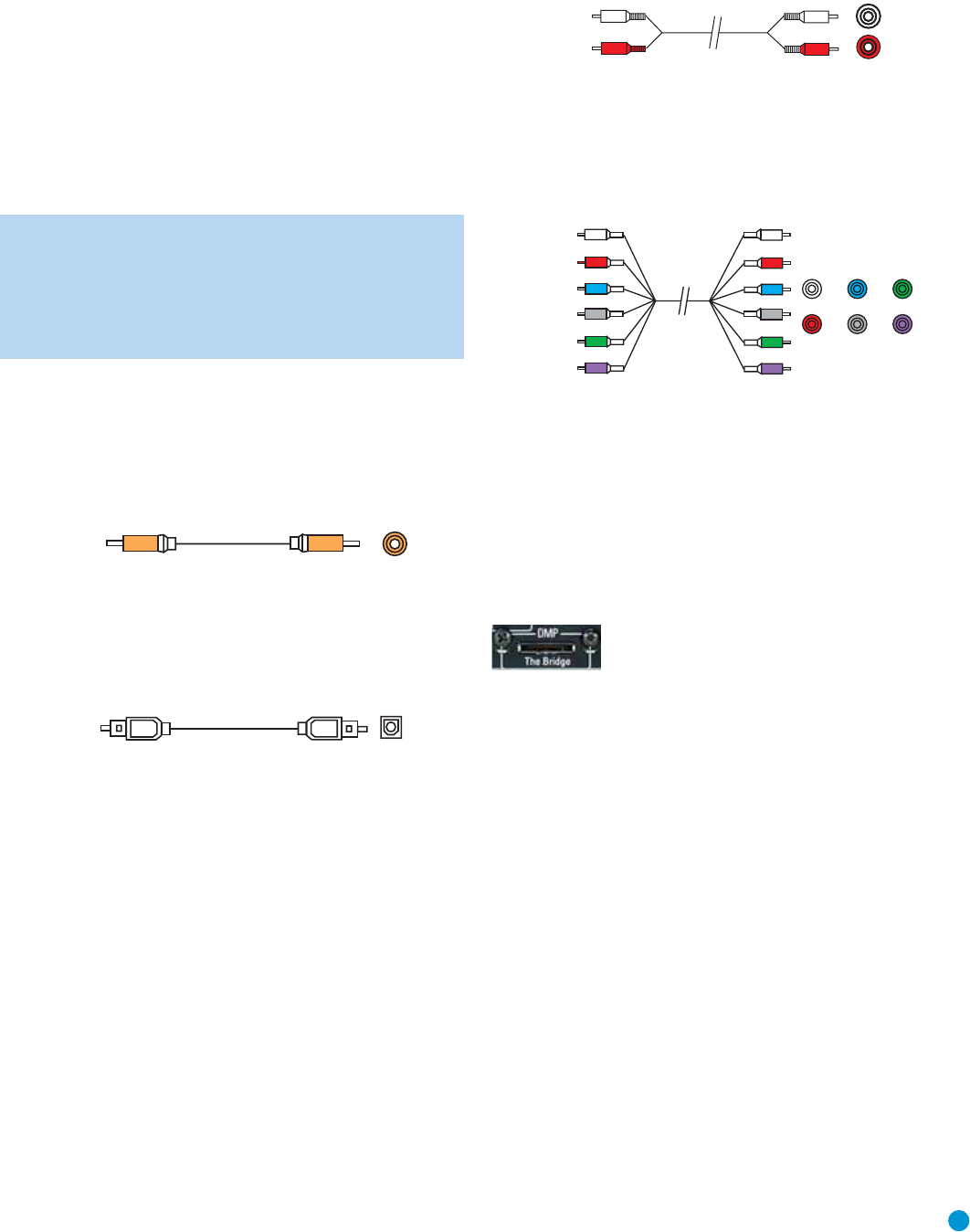
17
17
CONNECTIONS
Audio Connections
There are two formats for audio connections: digital and analog. Digital
audio signals are of higher quality, and are required for listening to
sources encoded with digital surround modes, such as Dolby Digital and
DTS.There are two types of digital audio connections: coaxial and optical.
Either type of digital audio connection may be used for each source
device, but never both simultaneously for the same source. However, it’s
okay to make both analog and digital audio connections at the same
time to the same source.
NOTE: Although HDMI cables are capable of carrying digital
audio signals, the AVR 146 is not designed to process those
signals. Therefore, if your source and video display are both
HDMI-capable, use the HDMI connections for video only. Make
a separate audio connection from the source device to the
AVR 146, and turn the volume on your TV all the way off.
Digital Audio
Coaxial digital audio jacks are usually color-coded in orange. Although
they look similar to analog jacks, they should not be confused, and you
should not connect coaxial digital audio outputs to analog inputs or
vice versa. See Figure 4.
Figure 4 – Coaxial Digital Audio
Optical digital audio connectors are normally covered by a shutter to
protect them from dust. The shutter opens as the cable is inserted.Input
connectors are color-coded using a black shutter, while outputs use a
gray shutter. See Figure 5.
Figure 5 – Optical Digital Audio
Due to the nature of digital signals as binary bits, they aren’t subject
to signal degradation the way analog signals are. Therefore, the quality
of coaxial and optical digital audio connections should be the same,
although it is important to limit the length of the cable. Whichever type of
connection you choose, Harman Kardon recommends that you always
select the highest quality cables available within your budget.
Analog Audio
Analog connections require two cables, one for the left channel (white)
and one for the right channel (red). These two cables are often attached
to each other for most of their length. See Figure 6. Most sources that
have digital audio jacks also have analog audio jacks, although some
older types of sources, such as tape decks, have only analog jacks. For
sources that are capable of both digital and analog audio, you may wish
to make both connections. If you wish to record materials from DVDs
or other copy-protected sources, you may only be able to do so using
analog connections. Remember to comply with all copyright laws if you
choose to make a copy for your own personal use.
Figure 6 – Analog Audio
Multichannel analog connections are used with some high-definition
sources where the copy-protected digital content is decoded inside
the source. These types of connections are usually used with DVD-
Audio, SACD, Blu-ray Disc, HD-DVD and other multichannel players.
See Figure 7.
Figure 7 – Multichannel Analog Audio
Harman Kardon receivers also include a proprietary, dedicated audio
connection called “The Bridge/DMP”. If you own an iPod with a dock
connector, you may purchase The Bridge separately and connect it to
The Bridge/DMP port on the receiver. See Figure 8. Dock your iPod
(not included) in The Bridge, and you may play your audio and video
materials through your high-performance system. You may even use
the AVR 146 remote to control the iPod, with navigation messages
displayed on the front panel and on the screen of a video display
connected to the AVR.
Figure 8 – The Bridge
Video Connections
Although some sources produce an audio signal only (e.g., CD player,
tape deck), many sources output both audio and video signals (e.g.,
DVD player, cable television box, HDTV tuner, satellite box, VCR, DVR).
In addition to the audio connection, you will need to connect one type
of video connection for each of these sources (never more than one at
the same time for any source).
Digital Video
The AVR 146 is equipped with two HDMI (High-Definition Multimedia
Interface) inputs, and one output. HDMI is capable of carrying digital
audio and video information using a single cable, thus delivering the
highest possible quality picture and sound.
There are different versions of HDMI, depending on the capability of the
source device and the type of signal it is capable of transmitting via the
HDMI connection.
In addition, receivers and processors such as the AVR 146 may handle
the incoming signal in several different ways, depending on their capability
as well. The AVR 146 is only capable of switching the HDMI data. That
is, the incoming audio and video data, including 1080i and 1080p video,
will be passed directly to your HDMI-capable video display, without the
Multichannel
analog audio
cable (RCA)
Front Surround Center
Subwoofer
L
R
A
nalog audio
cable (RCA)
O
pt
i
ca
l
Optical digital
audio cable
Coaxial
Coaxial digital
audio cable
AVR146-OM.qxd 2/5/07 3:58 PM Page 17


















